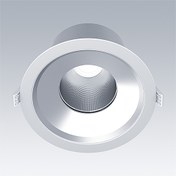Chalice 3 / CHAL3 200 5000-840 HFIX FL RSB
92989424
▼ Data Sheet
A high efficient and sustainable LED downlight for high ceiling application with flood beam (29°) for high ceiling applications. Suitable for mounting in Ø200mm cut-out with spring clips. Remote, pluggable, DALI-2 dimmable LED driver with DC functionality, adjustable 15-100%, NFC configurable, SwitchDIM compatible.Loop in - loop out possible. Body: die-cast aluminium for high efficient thermal management with recycling content >90%. Diffuser: polycarbonate. Reflector and trim: polycarbonate smooth reflector in satinbrite finish with wide beam. Class II electrical (this product is not earthed), IP20. Complete with 4000K LED
Installation in concrete ceilings not permitted.
Dimensions: Ø223 x 134 mm
Luminaire input power: 43.7 W
Luminaire luminous flux: 5541 lm
Luminaire efficacy: 127 lm/W
Weight: 1.41 kg
- LED
- CE
- NoIsol
- ENEC11
- GLedReP
- 850°
- Halogenfree
- IK07
- IP20
- LLedNr
- RG1
- SC2
- Ta=25
- UKCA

